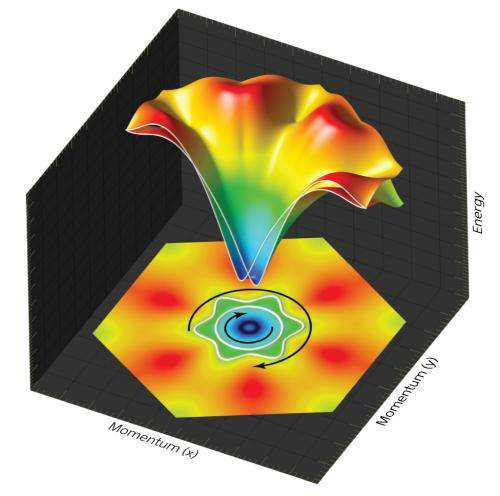Researchers detect elusive quantum property known as 'Berry's phase' in a semiconductor

In conducting materials, free electrons can move from one point to another, conveying their electrical charge to produce an electrical current. Electrons have another property, known as spin, that could be harnessed and manipulated in 'spintronic' circuits and has the potential to revolutionize the field of conventional electronics, leading to new functionalities and devices with enhanced performance.
Controlling electron spin states, however, is not as straightforward as controlling charge, making the development of practical spintronics a significant challenge. Quantum theory predicts that certain exotic energy states produced by the motion of electrons in solid matter could be used to control electron spin. Yet it is only recently that scientists have even been able to observe such exotic quantum energy states in the lab.
Hiroshi Murakawa and colleagues from the RIKEN Center for Emergent Matter Science, in collaboration with co-workers from the University of Tokyo and the SLAC National Accelerator Laboratory in the United States, have for the first time experimentally detected an elusive quantum property known as Berry's phase in a semiconductor.
Breaking waves to find the phase
"Berry's phase is a ubiquitous and fundamental notion in quantum physics," says Murakawa. Berry's phase gives rise to emergent phenomena such as the quantum version of the classical Hall effect—a transverse electrical current induced by an external magnetic field—as well as novel materials called topological insulators, which act as insulators in their bulk but conduct electricity on their surfaces.
"In quantum mechanics, an electron's motion, behavior and state are described by its wavefunction, which is characterized by an amplitude and a phase," explains Murakawa. "Typically, the phase reflects the time evolution of the electronic state and depends on energy and momentum terms. Berry's phase, on the other hand, is independent of time and reflects the system geometry. Geometrical information can therefore be encoded in the wavefunction and govern the motion of electrons."
It is these geometrical properties, such as the relative orientation of an electron's spin or momentum, that can give rise to Berry's phase. Most commonly, Berry's phase occurs in systems that are subjected to gradually changing cyclic processes that do not involve the transfer of heat or matter between the system and its surroundings. This condition is generally only met when the system has time to adapt its configuration to the changing conditions, such as when particles undergo rotation or translation.
"When the spin Berry's phase exists," says Murakawa, "novel phenomena such as spin-polarized charge flow without enegy dissipation can be realized. Despite its ubiquity and importance, however, experimental observation of Berry's phase stemming from electron spin is challenging."
Finding materials with the right split
An electron's spin can be either 'up' or 'down'. In most materials, electrons in spin-up states have almost identical energy to those in spin-down states. This leads to a phenomenon called energy degeneracy, in which the two states are difficult to distinguish. In their search for real manifestations of Berry's phase, Murakawa and his colleagues had to overcome the complication of energy degeneracy. They did so by focusing their attention on the semiconductor bismuth tellurium iodide (BiTeI)—a material with an unusual atomic structure consisting of stacked layers of its three individual component elements (Fig. 1).
The interfaces between the layers in BiTeI destroy the symmetry of the atomic lattice and give rise to a strong coupling between electron spin and motion, known as spin–orbit interaction. The overall result, known as Rashba splitting, is the removal of energy degeneracy, allowing different states to be easily observed (Fig. 2).
"Rashba semiconductors have not been applied practically until now, mainly due to the lack of an ideal system," says Murakawa. "The three-dimensional crystal structure of BiTeI allows a Rashba spin split to occur on a bulk scale, resulting in a huge number of spin-polarized electrons."
Observing oscillations
The researchers produced a series of single-crystal BiTeI samples with different electron carrier densities by growing the crystals at different temperatures. They then measured the electrical resistance of thin plates of the material. They also measured the Hall effect resistivity of the crystal under a strong magnetic field at temperatures of less than 2 kelvin—close to absolute zero.
The team was looking for the Shubnikov–de Haas (SdH) effect, a telltale sign of quantum behavior, by which free electrons behave like simple harmonic oscillators, fluctuating up and down in energy. This can be observed as an oscillation in magnetoresistivity with increasing magnetic field strength in materials at very low temperatures. In BiTeI, two sets of these oscillations corresponding to the two possible spin states could be clearly identified—the result sought after by Murakawa and his team. "The extremely large Rashba energy splitting in BeTeI enabled us to analyze each oscillation peak separately and disclose the spin Berry's phase clearly," he notes.
Murakawa suggests that it might be possible to induce persistent charge flow without energy loss by improving the crystal quality or optimizing the carrier concentration of BiTeI. The researchers are hopeful that they will eventually be able to control non-dissipative transport properties through the manipulation of Berry's phase.
More information: Murakawa, H., Bahramy, M. S., Tokunaga, M., Kohama, Y., Bell, C., Kaneko, Y., Nagaosa, N., Hwang, H. Y. & Tokura, Y. Detection of Berry's phase in a bulk Rashba semiconductor. Science 342, 1490–1493 (2013). dx.doi.org/10.1126/science.1242247
Journal information: Science
Provided by RIKEN





















